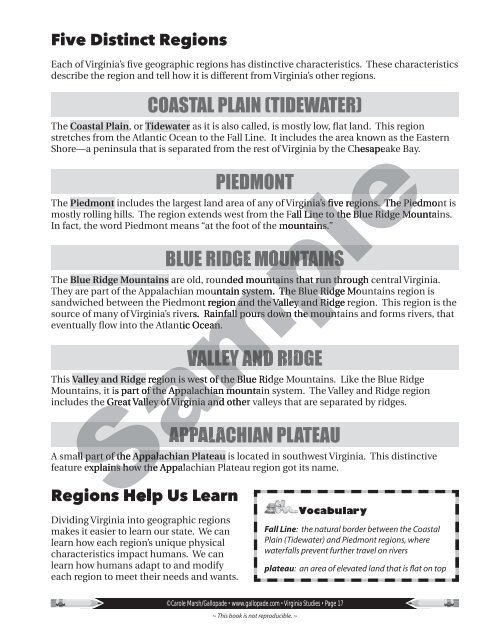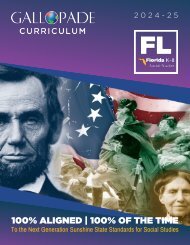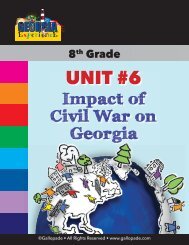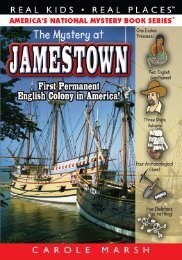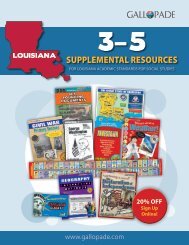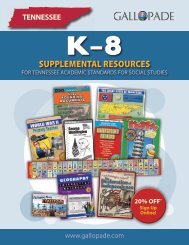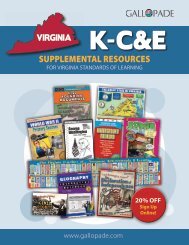Virginia Experience Virginia Studies Solution History • Geography • Government • Economics
The Virginia Experience effectively teaches students about United States history. All curriculum materials cover important geography, American Indians, colonization American Revolution, westward expansion, Civil War, and 20th century Virginia required by the Virginia Standards of Learning (SOL).
The Virginia Experience effectively teaches students about United States history. All curriculum materials cover important geography, American Indians, colonization American Revolution, westward expansion, Civil War, and 20th century Virginia required by the Virginia Standards of Learning (SOL).
Create successful ePaper yourself
Turn your PDF publications into a flip-book with our unique Google optimized e-Paper software.
Five Distinct Regions<br />
Each of <strong>Virginia</strong>’s five geographic regions has distinctive characteristics. These characteristics<br />
describe the region and tell how it is different from <strong>Virginia</strong>’s other regions.<br />
COASTAL PLAIN (TIDEWATER)<br />
The Coastal Plain, or Tidewater as it is also called, is mostly low, flat land. This region<br />
stretches<br />
Sample<br />
from the Atlantic Ocean to the Fall Line. It includes the area known as the Eastern<br />
Shore—a peninsula that is separated from the rest of <strong>Virginia</strong> by the Chesapeake Bay.<br />
PIEDMONT<br />
The Piedmont includes the largest land area of any of <strong>Virginia</strong>’s five regions. The Piedmont is<br />
mostly rolling hills. The region extends west from the Fall Line to the Blue Ridge Mountains.<br />
In fact, the word Piedmont means “at the foot of the mountains.”<br />
BLUE RIDGE MOUNTAINS<br />
The Blue Ridge Mountains are old, rounded mountains that run through central <strong>Virginia</strong>.<br />
They are part of the Appalachian mountain system. The Blue Ridge Mountains region is<br />
sandwiched between the Piedmont region and the Valley and Ridge region. This region is the<br />
source of many of <strong>Virginia</strong>’s rivers. Rainfall pours down the mountains and forms rivers, that<br />
eventually flow into the Atlantic Ocean.<br />
VALLEY AND RIDGE<br />
This Valley and Ridge region is west of the Blue Ridge Mountains. Like the Blue Ridge<br />
Mountains, it is part of the Appalachian mountain system. The Valley and Ridge region<br />
includes the Great Valley of <strong>Virginia</strong> and other valleys that are separated by ridges.<br />
PLATEAU<br />
A small part of the Appalachian Plateau is located in southwest <strong>Virginia</strong>. This distinctive<br />
feature explains how the Appalachian Plateau region got its name.<br />
SAPPALACHIAN<br />
Sample<br />
Regions Help Us Learn<br />
Dividing <strong>Virginia</strong> into geographic regions<br />
makes it easier to learn our state. We can<br />
learn how each region’s unique physical<br />
characteristics impact humans. We can<br />
learn how humans adapt to and modify<br />
each region to meet their needs and wants.<br />
Vocabulary<br />
Fall Line: the natural border between the Coastal<br />
Plain (Tidewater) and Piedmont regions, where<br />
waterfalls prevent further travel on rivers<br />
plateau: an area of elevated land that is flat on top<br />
©Carole Marsh/Gallopade <strong>•</strong> www.gallopade.com <strong>•</strong> <strong>Virginia</strong> <strong>Studies</strong> <strong>•</strong> Page 17<br />
~ This book is not reproducible. ~


